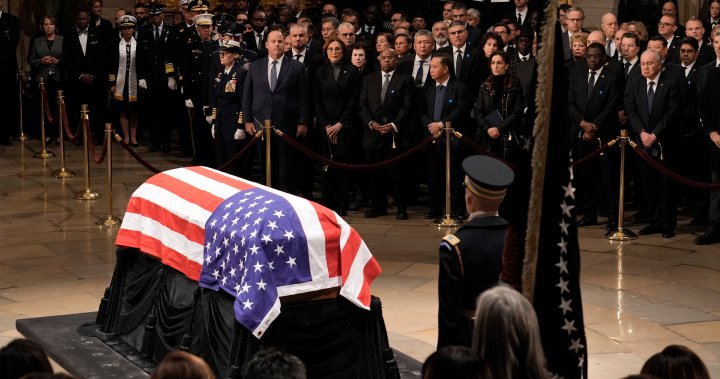If you’re part of a joint bank account or have co-signed a mortgage, you might be part of something called a “bare trust” agreement that many Canadians will have to file a tax return for in the coming weeks.
Bare trusts aren’t new, but this year is the first time the arrangements must be filed and reported to the Canada Revenue Agency (CRA) for the 2023 tax year. If the April 2 deadline isn’t met, some hefty penalties could apply.
“It’s very important that all Canadians really take a good stock of whatever bare trust they may have in their world and get compliant as soon as possible,” says Ameer Abdulla, a tax expert at Ernst & Young (EY).
Since the rule is new this year, many Canadians may be unaware that they have to file a bare trust return within the next few weeks.
Here’s everything you need to know:
What is a bare trust arrangement?
Trust funds are commonly used by anyone looking to safeguard their assets upon their death or to provide protections for young or vulnerable individuals who receive the funds, called beneficiaries.
Bare trusts happen when someone legally owns an asset, but it technically belongs to someone else. The arrangement is essentially a separation of legal and beneficial ownership of a property.
Abdulla describes bare trusts as “when the legal ownership of a thing or a piece of property or an account does not match who is entitled to that property, that income or the gain on that property.”
The difference between a bare trust and other trust accounts is that the trustee in the former has no decision making power over the beneficiaries assets. The trustee only acts on the beneficiary’s instructions.
“For bare trust, I think a lot of them are typically innocent, like having an account for your minor child to hold birthday money, or partnering with your elderly parent who may or not be losing some of their memory. It’s a very practical way to deal with those sorts of things,” Abdulla says.

The CRA defines bare trusts as “a trust arrangement under which the trustee can reasonably be considered to act as agent for all the beneficiaries under the trust with respect to all dealings with all of the trust’s property.”
Financial news and insights
delivered to your email every Saturday.
Financial news and insights
delivered to your email every Saturday.
Examples of a bare trust arrangement, according to the CRA, would be:
- A financial account made by a parent or grandparent for a minor
- Any joint bank account: For example, between an adult child and their elderly parent
- A parent co-signing a mortgage for their child
Trusts that hold less than $50,000 in assets may be exempt from the reporting requirements. Out of the examples above, this is likely the scenario for most joint accounts between family members.
In order for a co-signed mortgage to count as a bare trust agreement, Abdulla says financial institutions require the parent to also be included on the title.
“It’s the being on title that could create the bare trust arrangement because then you have a number of people on the legal title for a home or a condo, and the beneficial ownership might not be all the people listed,” he explains.
A growing portion of Canadians likely fall into this category of mortgage co-signers for their child or grandchild, as young people’s wages continuously struggle to keep up with the rising cost of living and homeownership. Especially after the COVID-19 pandemic, aspiring homeowners without family financing are running out of options.
Royal LePage says an online survey by Leger of more than 500 respondents in August 2023 showed six per cent of homeowners currently co-own their property with someone other than their spouse or significant other. Only 44 per cent of respondents from this group said they live with all other co-owners named in the deed.
If you are unsure about whether you’re part of a trust agreement that now requires a T3 return, a press release by EY advises Canadians to seek legal counsel.
I have a bare trust. What do I need to know to file?
For the first time, bare trusts are required to file T3 Trust Income Tax and Information Returns for the 2023 year.
The CRA’s deadline for trustees to file is April 2 — which notably comes before the general April 30 tax deadline for individuals.
If Canadians don’t file their bare trust returns by the deadline, they could face multiple fees or penalties. Typically, the fee is $25 per day for late filing, with a minimum penalty of $100 and maximum of $2,500.
Abdulla notes that in some cases, a gross negligence penalty with no maximum may apply.
“Those can be assessed as the lesser of $2,500 or five per cent of the trust’s property. But it’s that second penalty, that second threshold that has no limit and it’s quite significant,” he says.
However, if you miss the deadline this year, you might be in the clear. The CRA announced this week that because the new bare trust rules may be unfamiliar to Canadians, the agency will be offering relief from the penalty and will only pursue blatant cases of gross negligence.
“As some bare trusts may be uncertain about the new requirements, the CRA is adopting an education-first approach to compliance and providing relief to bare trusts by waiving the penalty payable under subsection 162(7) of the Income Tax Act for the 2023 tax year in situations where the T3 Return and Schedule 15 are filed after the filing deadline for reasons other than gross negligence,” the CRA explains.
Abdulla says that if you have a bare trust arrangement, your first step is to obtain a trust identification number. There is a process to apply for one on the CRA’s website, but then you will be able to file electronically.
“Alternatively, you do have to file an actual T3 trust income tax return which is a bit more difficult than a typical, personal tax return. And so we find it’s very important for Canadians to… identify the best way to file that trust tax return as soon as possible,” Abdulla says.

‘Double whammy’: Schedule 15 is also a new requirement this year
Once bare trusts have filed their T3, they aren’t completely out of the woods. Abdulla says there’s one more requirement to be aware of, called Schedule 15, also known as a Beneficial Ownership Information of a Trust.
Essentially, a schedule is attached to the trust’s tax return to keep track of beneficial owner information. There, you have to list all the beneficial owners and trustees of the trust.
Even if the trust has no income to report, the new Schedule 15 forms are part of the T3 Return and therefore can’t be filed on their own.
“That’s certainly very different from 2023. Even if you had filed the bare trust return in 2022 or 2021, you may not have or you absolutely did not have to file that Schedule 15,” Abdulla says.
“It’s sort of a double whammy.”
Abdulla says if you’re worried about the new filing rules, take comfort in knowing that reporting becomes “relatively straightforward and much easier” each year.
He says the CRA’s website can offer guidance to Canadians uncertain about the process. For example, the CRA has a step-by-step guide on filing T3 trust returns.
“Certainly, the change for 2023 of, you must file (T3) and you must file Schedule 15, would appear to be very daunting for many Canadians. But certainly I can offer encouragement that the first one is the hardest,” Abdulla says.





